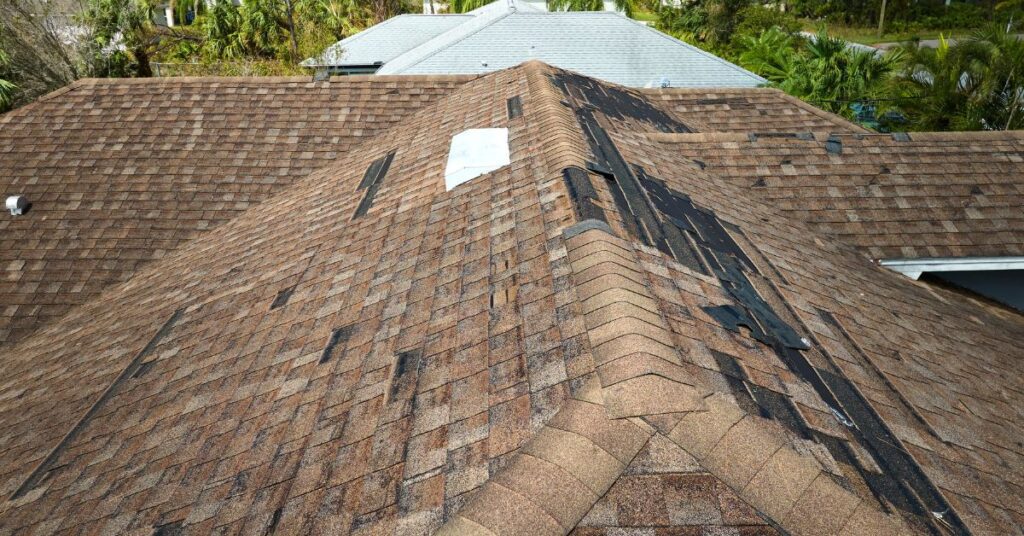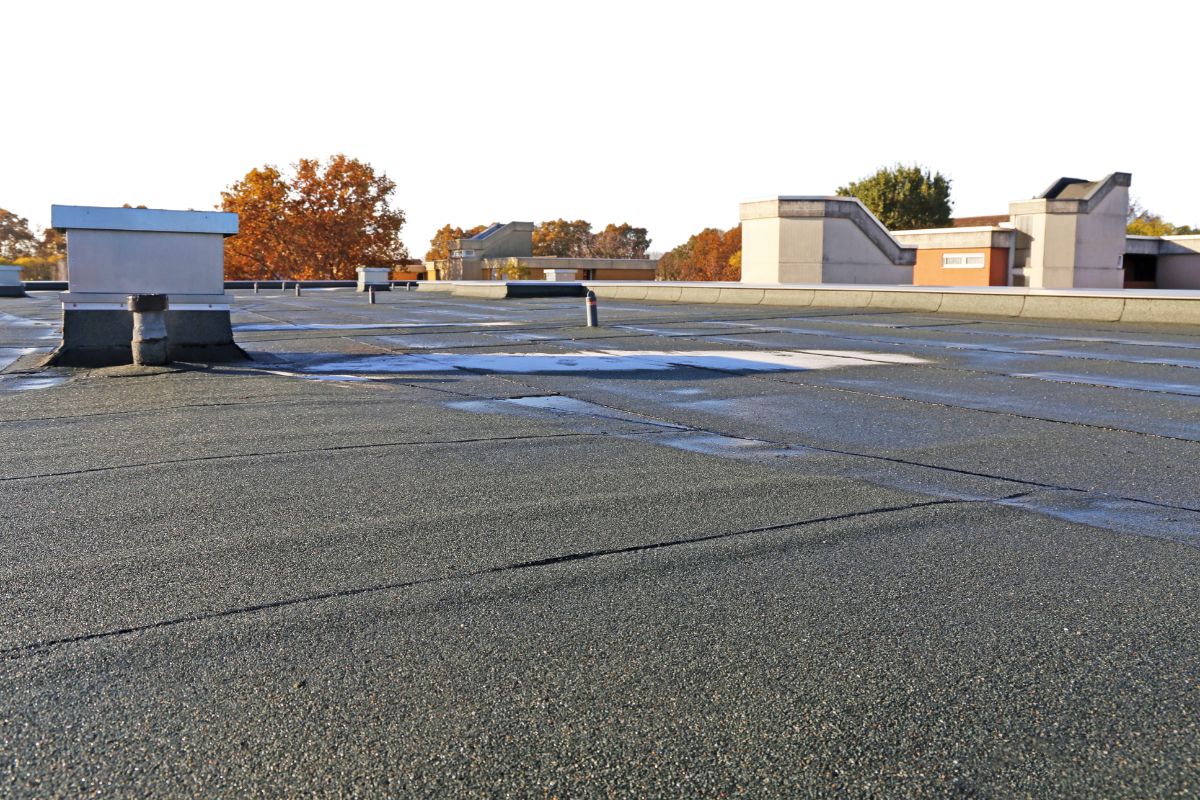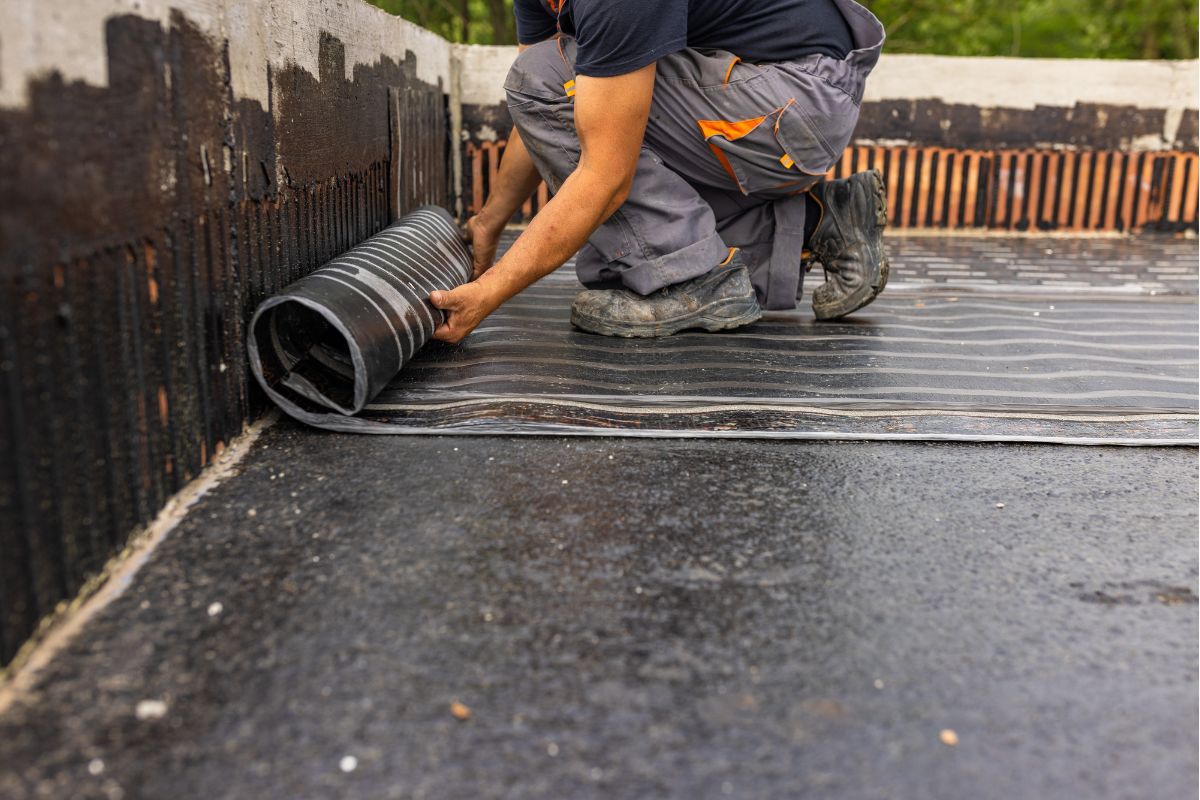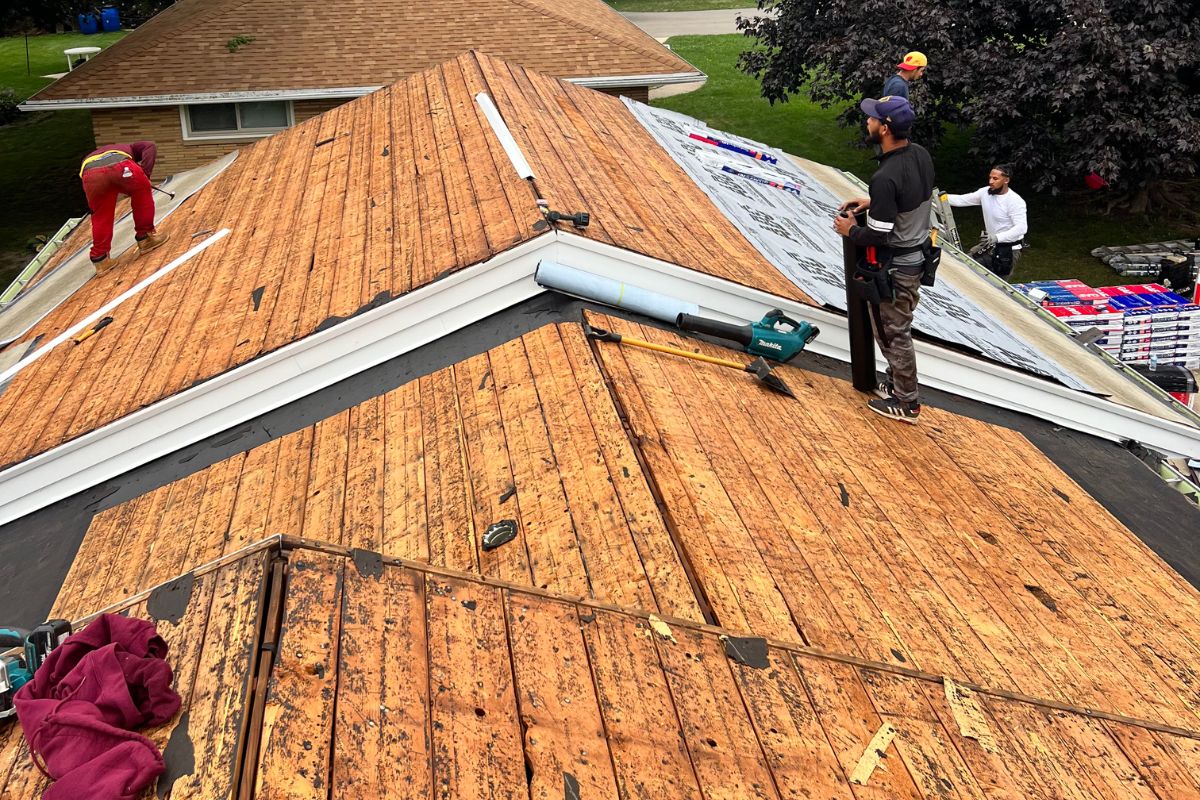Hail damage can lead to dents, granule loss, cracked shingles, and hidden structural issues. Perform a visual inspection or hire someone to do that and find common signs of damage, such as splatter marks, bruised shingles, granules in gutters, and dents on metal surfaces. Repairing the roof is mandatory after a hailstorm to prevent water infiltration, mold growth, and escalating repair costs.
What Is Hail Damage?
Hail damage is the circular dents, punctures, or blemishes caused by hailstones to residential and commercial buildings. Hail impacts can cause significant structural damage as well as cosmetic damage. If left unchecked, the entire roof of a structure might need to be removed.
Types of Roof Damage Caused by Hail
Granule loss
Granule loss occurs when hail impacts dislodge the granules embedded in the asphalt shingles. It is one of the most common types of hailstorm damage. Granules act as a protective layer for shingles, shielding them from UV light and the weather. Damage to shingles lessens the overall lifespan of the roof.
Dented gutters
Depending on the extent of hail damage, dented gutters can lead to disruptions of water flow, leading to water damage and structural issues. Hail impacts cause damage to siding, dents in metal gutters, or even punctures, debilitating roofing components..
Splatter marks
Splatter marks, or spatter marks, are bruising marks on roofing components. These are dark or light spots from hail damage that haven’t broken the surface layer and generally don’t signify any structural damage.
Broken roofing materials
Broken roofing materials- cracking or shattering of asphalt shingles, tiles, panels, etc- is a common scenario after hailstorms. The damage can lead to water leaks and decrease the roof’s lifespan if left unchecked.
Fractured fibreglass mats
Fractured fibreglass mats can necessitate a complete roof replacement even if the roof surface appears to be fine. Fibreglass mats are set under the granules and asphalt and can crack from random damage such as hailstorms. Its inability to be visually inspected makes it particularly vulnerable.
Weakened seals
Weakened seals are a result of damage to the adhesive strips that bind the asphalt shingles to the underlying layer of the roof. Weakened seals lead to other obvious damage through compromised waterproofing and increase the risk of shingle loss during storms.

Signs of Hail Damage: What to Look For
Obvious signs of hail damage
Missing shingles
Gaps or missing shingles on the roof are an obvious indicator of possible hail damage. One needs to look around the area of the roof to search for cracked shingle pieces dislodged due to hail impact
Broken or cracked tiles/shingles
Obvious signs of cracks or splits in the clay tiles or similar damage to asphalt shingles are indicators of a direct hit from hailstones.
Dents on the metal components
Finding circular dents of different depths on the roofing components- gutters, downspouts, vents, and other metal parts- is a common sign of hail damage.
Holes or punctures
Visible holes or punctures in the roofing materials require significant force, which are almost exclusively caused by severe hail damage.
Damage to flashing or vent caps
Dented, pockmarked, or torn flashings near the roofing components, such as chimneys or vents, signify hail damage.
Slight damage
Finding broken or cracked glass in the skylight is also an obvious indicator of hail damage.
Subtle indicators of hail damage
Granule loss
Visible bald spots on asphalt shingles due to impact from hailstones and finding granules in gutters or around the house are subtle signs of hail damage.
Bruised shingles
Soft spots on shingles or weakened areas that feel spongy can indicate that the roof has suffered from hail damage.
Weakened shingle seals
Lifted or unsealed edges of individual shingles might indicate that the adhesive has been damaged by hailstones. This can lead to reduced wind resistance and minor leaks
Splatter marks
Hailstone damage to shingles dislodges dust or oxidation. This may cause discolored spots.
Internal leaks or water stains
Hail damage can cause hidden indoor water damage. These show themselves as water stains on walls or ceilings, mold or mildew growth that may even occur weeks after the storm.
Algae or moss growth
Moisture retention in shingles occurs after receiving external damage to asphalt shingles, and there is a path for water to seep in. The excess moisture allows for algae and moss growth.
Assessing the Severity and Extent of Damage
Assessing the severity of damage to the structure needs a few areas to be covered. First, one needs to check the entire roof and other affected areas for signs of damage and document the extent of hail damage by taking notes and photographs according to need. The different types of damages must then be categorized based on severity to prioritize which ones need faster repairs. Separating one type of damage from the other is done based on how much area is affected and the volume of the roofing components damaged. One might need professional tools such as laser scanners. The root cause needs to be found out, especially for insurance claims. Finally, the cost of the repairs is needed. Expenses are calculated based on factors such as the area and volume of the roofing materials damaged and the type of roof material used on the roof. The cost of hiring an experienced inspector is also a significant decision, so that all the estimates are correct.
Roof Types and Their Vulnerabilities
- Asphalt Shingles: Asphalt shingle roof replacements are the most common. These are prone to damage, such as wind damage, granule loss, cracking, or curling, etc.
- Wood Shingles are made from cedar or redwood. Frequent risks to wood shingles are rotting, mold growth, fire, and insect infestation.
- Metal Roofs: made from steel, aluminum, or copper. Vulnerabilities of metal roofs are denting, corrosion, fastener issues, etc.
- Impact-Resistant Shingles: a subtype of asphalt shingles.Also known for being a roof with impact resistance. Common risks are cracking under extreme impact, granule loss, installation errors, etc.
Steps to Take After a Hailstorm
Check for safety hazards
Ensure that the property is safe before starting an inspection on the roof for damage. Avoid walking on a potentially damaged roof.
Document the damage and weather
Take photo-rich notes of the visible damages and collect the weather report
Visual inspection
Do an initial check for obvious damage, such as pieces of cracked shingles around the perimeter.
Mitigate further damage
Cover exposed areas with tape and leaks to keep the damage from worsening.
Contact your insurance company
Contact your insurance carrier or insurance provider for homeowners’ insurance coverage.
Review the insurance policy
To be aware of all the factors necessary. The insurance policy may differ based on different insurance companies.
Schedule a professional inspection
Make sure that the contractor is experienced and that there are no hidden damages to the structure.
Hire a reputable contractor
Choose a contractor from a professional roofing company with a good track record after reviewing multiple contractors and their estimates before starting the repairs. If you are in Wisconsin and need reliable roof repair service, Northern Generation can help you. We are local, insured and highly professional.
Professional vs. Visual Inspection
| Aspect | Visual Inspection | Professional inspection |
| Done by | Homeowner/ untrained people | Licensed roofing professional/roofing contractor/roofing experts |
| Methods and tools | Visual observation: ladders and binoculars | Visual inspection, binoculars, drones, measurement tools |
| Accuracy | Limited: may miss hidden damage | High: identifies all visual and hidden issues |
| Cost | Free | Depends on the contractor |
| Time needed | Can be done under an hour | It may take hours for a professional inspection |
| Purpose | To identify obvious damage and see if professional inspection is needed | To accurately assess the extent of damage. |
How to Claim Insurance Claims
- Contact the insurance company without delay and start the claims process for the claim for hail damage.
- Review the insurance policy to understand how to claim damage, coverage limits, deductibles, hail damage claims, claims for roof damage, and other factors.
- Take notes, photos, and video documentation of all the damage
- Prevent further damage from occurring and keep receipts for the actual cash credit cost incurred, as these may be reimbursable.
- Hire a licensed roofing contractor to identify hidden damages missed during the initial inspection
- Get replacement cost or repair estimates from different reputable roofing contractors and compare. See that the estimates detail material, labor, and timeline.
- Meet the insurance adjuster and be present during their inspection, ensuring no area or damage has been missed.
- Finally, submit the insurance claim form along with all the documents.
- Review the offer thoroughly and negotiate for a fair settlement if necessary
- Seek out companies such as Insurance Claim Recovery Support LLC, Goosehead Insurance, and American Family Insurance for additional support
- Approve repairs and keep documentation of all the work being done.
- File complaints in case of discrepancies.
How much hail damage is required for insurance to replace a roof?
On average, insurance replaces a roof if there have been 8+ impacts per 10ft x 10ft test square on three roof sides. This threshold is common for adjusters using HAAG engineering standards
How much hail damage is needed to replace a roof?
Choosing a roof replacement depends on the cost of repairs needed to choose. If the cost of the necessary repairs falls within ($8,000-15,000$), then it would be uneconomical to choose to repair as it would also decrease the roof lifespan
Insurance adjuster says no hail damage: What to do?- small bullet points
- Reviews the adjuster’s reports to understand their reasoning
- Collect additional evidence- photos, videos, weather reports- to justify your claim
- Get a second opinion from a licensed independent roofing contractor
- Hire a public adjuster if needed
- Request a re-inspection with a new adjuster to the insurer, along with all your documents
- File a formal appeal with your insurer, including the opinion of the independent contractor and your documents
- Contact the state insurance department and talk to an attorney if necessary
- Do not sign a settlement prematurely
Average insurance payout for hail damage roof
The insurance payout for hail damage depends on multiple factors. The extent of the damage and the type of roofing materials. The average insurance payout ranges between $5,000 and $15,000
How to choose Professional Hail Damage Roof Repairs – bullet points
- Ensure the professional roofing contractor is licensed by the state’s licensing board.
- The contractor must have general liability and workers’ compensation insurance
- Choose contractors that have previous experience with hail damage repair, like AmeriPro Roofing’s 150,000+ projects and Authority Roofing
- Select a contractor with insurance experience to be able to navigate insurance claims
- Avoid unlicensed contractors, as low-cost, bad roofing practices may cause permanent damage to the structure and deny insurance claims
Repair vs. Roof Replacement
It’s better to choose repairs when the roof is functional and only minor repairs are needed, or the repair costs are economical. But if the lifespan of the roof has been compromised, then a full roof replacement will be required to mitigate the issue. The cost of professional repairs or the cost of hail damage may vary based on the state and roofing company, which affects the decision
| Aspect | Roof Repair | Roof Replacement |
| Cost | Low cost | High cost |
| Roof lifespan | May decrease 20%-30% | Increases roof lifespan |
| Time | 1-3 days | 1-2 weeks |
| Span | Effective only in a localized area | Addresses all issues |
Should you perform Hail damage roof replacement?
Consider the roof replacement only when it is uneconomical to repair or when the costs exceed ($4000-8000$ range. A roof replacement can take up to 2 weeks, which is significant when compared to a roof repair that may take 1-3 days
Preventing Future Storm Damage
- Installation of impact-resistant shingles
- Securing the roof structure for future storms with braces and hurricane clips.
- Ensuring gutter and drainage efficiency to prevent pooling
- Remove dead limbs of trees and other debris from the roof.
- Regular roof care from the homeowners, such as scheduling regular inspections
- Taking proactive steps in not letting existing problems worsen and ensuring prompt repairs
Hail Damage Beyond the Roof
- Damage to building materials other than the roof, such a sidings, skylights, gutters, downspouts, etc
- Insurance claims are a strenuous process for property owners, which also has a risk factor
- Commercial building owners may lose tenants if the repairs take significant time to get done
Hail damage roof repair cost
Hail damage repair costs can fall in the range between $150 and-12,500, while the US average is $4250. The cost varies based on multiple factors such as the area/volume of the damage, the materials being used, and differing labor rates in different states.








